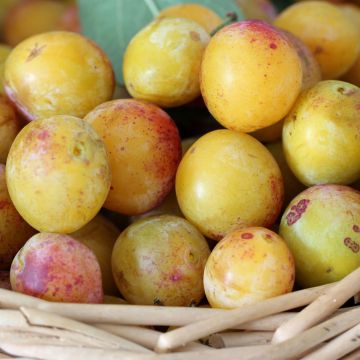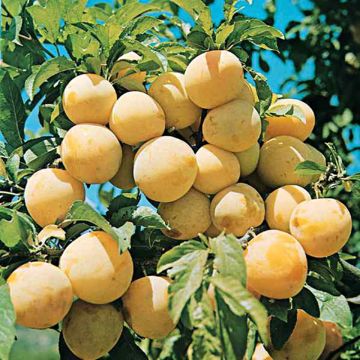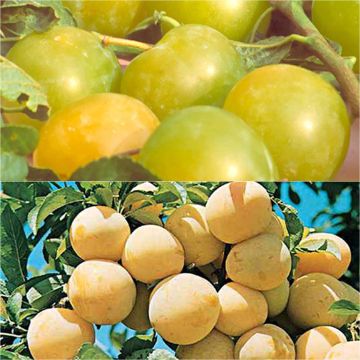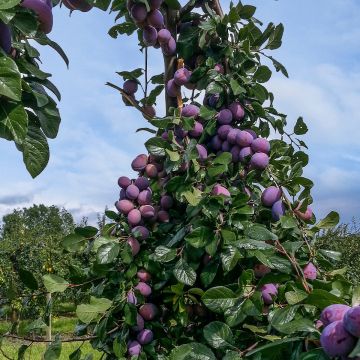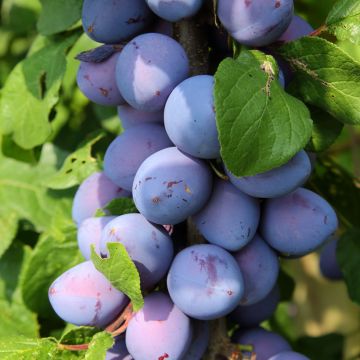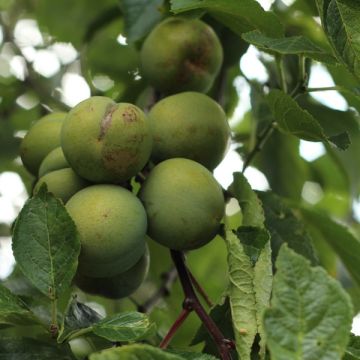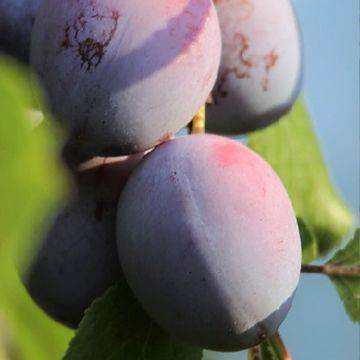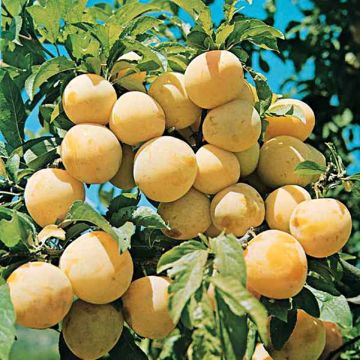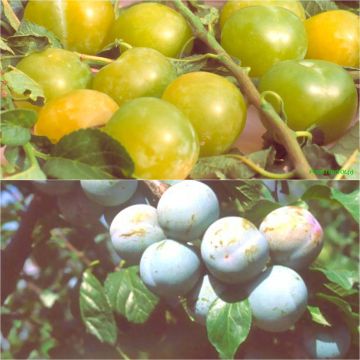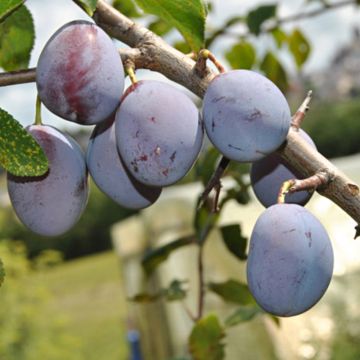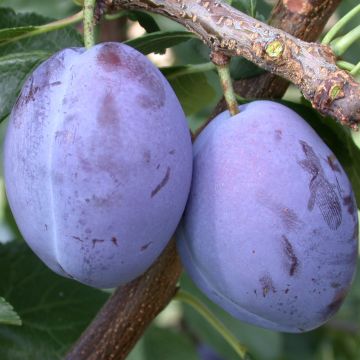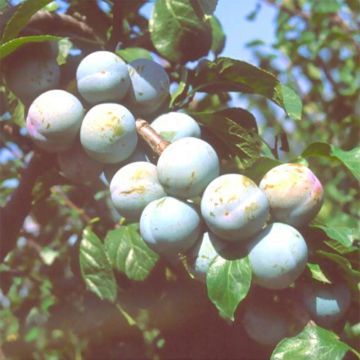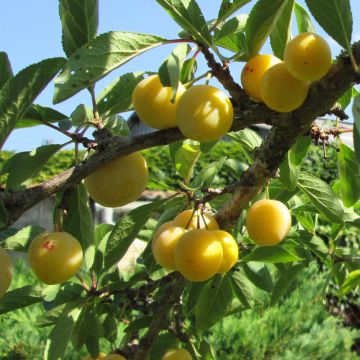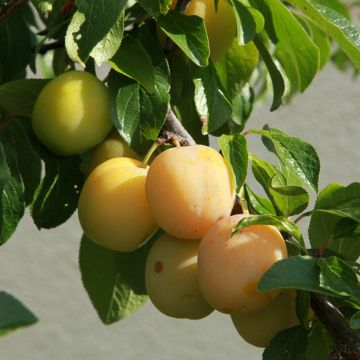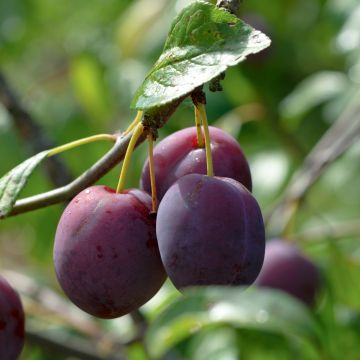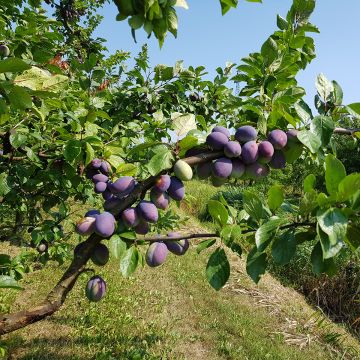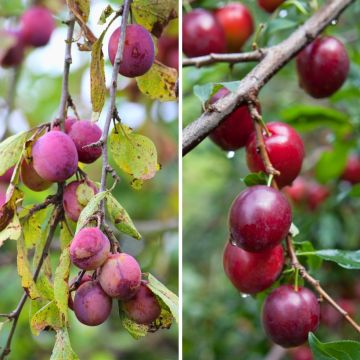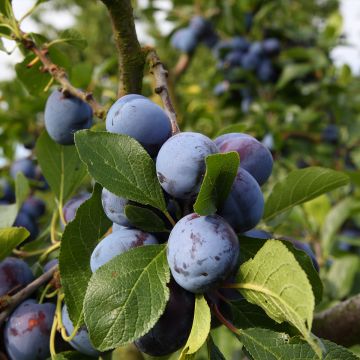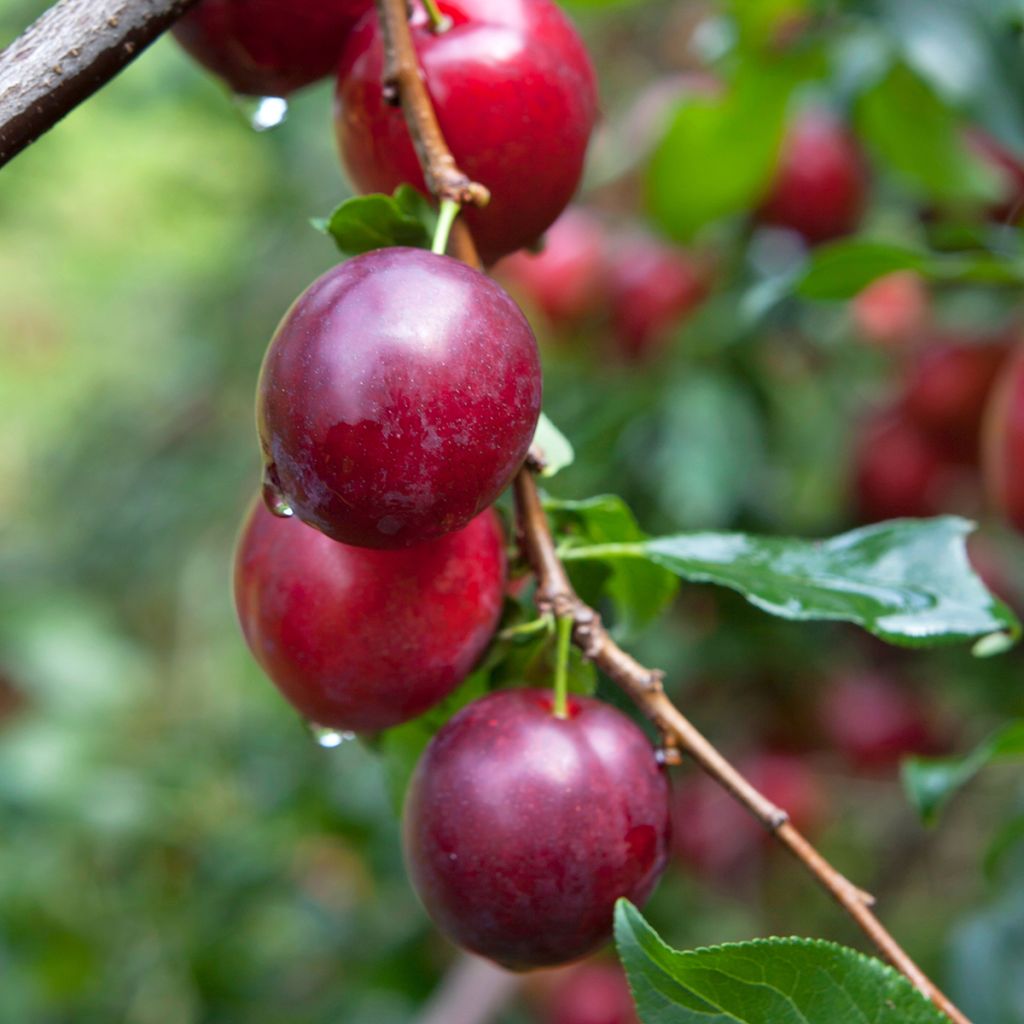

Prunus domestica Opal
Prunus domestica Opal
Prunus domestica Opal
European plum, common plum
Why not try an alternative variety in stock?
View all →This plant carries a 6 months recovery warranty
More information
We guarantee the quality of our plants for a full growing cycle, and will replace at our expense any plant that fails to recover under normal climatic and planting conditions.
From €5.90 for pickup delivery and €6.90 for home delivery
Express home delivery from €8.90.

Description
The Opal Plum is characterised by its vigour and hardiness, as well as abundant and regular yields. It produces small round to oval plums, purple-red on a yellow background. Its pale yellow flesh is firm, juicy, and highly aromatic. The harvest begins at the end of July and continues until August. This fruit can be eaten fresh or used in desserts or preserves. This self-fertile variety proves to be a very good pollinator. It has proven itself over many years for its good disease resistance.
Plant from Organic Agriculture.
Prunus domestica (Common Plum) is a fruit tree belonging to the Rosaceae family, just like the apricot tree, almond tree, and peach tree. It is native to Syria, where it sometimes grows up to 1000 metres in altitude.
The 'Opal' variety was selected in 1925 by the Alnarp Research Institute in Sweden. It is the result of cross-breeding between the Early Favourite and Reine-claude d'Oullins varieties. It forms a fruit tree with a fairly rounded structure that can reach a final height of about 5 metres, producing numerous branches grouped in spreading crowns. Its habit is well suited to free forms on high, half, or low stems. Its deciduous foliage is composed of obovate, 6 to 8 cm long, scalloped and toothed leaves, slightly hairy underneath and dark green. Towards the end of March, beginning of April, the white, 1.5 to 2.5 cm diameter flowers, appear solitarily, before the leaves on the previous year's branches. The flowering is sensitive to spring frosts, but it is so abundant that frost rarely compromises the harvest. It is a remarkably decorative flowering in spring, particularly nectar-rich. It is hardy to -20°C. This variety is self-fertile, so it does not need a companion to bear fruit, but the presence of another variety of plum tree nearby will increase production.
Prunus domestica 'Opal' is a fertile variety with quick fruiting. The fruits can be harvested from late July to mid-August, as they ripen. Since plums are quite fragile, harvest carefully with a picking pole or manually with a ladder. On average, a plum tree produces between 25 and 50 kilograms of fruit per year. The fruits can be consumed as soon as they are harvested. They are small, ovoid, 2.5 to 3 cm in diameter plums, with delicious and flavourful flesh. The plums can be eaten fresh right after picking, eaten raw or mixed in a fruit salad, or used in desserts. They are also exquisite in the making of clafoutis, cakes, crumbles, or pies, and as an accompaniment to savoury dishes based on white meats (turkey, chicken, veal...) or tagines. They are also perfect for making jams, compotes, or preserved in syrup.
The plum is a light and balancing fruit. It is low in calories and rich in potassium, calcium, and magnesium, with a significant iron content. Its content of vitamins C, B, E, and K, phenolic antioxidants, and fibre make the plum a healthy choice. It is invigorating, energising, and rehydrating.
The Opal Plum is a very interesting variety of the mirabelle Plum category. Its major asset is the taste quality of its fruits, but it is also very vigorous, hardy, and highly productive. It resists diseases well and, under favourable conditions, it is easy to cultivate. It prefers rich, deep, and well-drained soils, without excess water and in full sun. It should be protected from frost and strong winds, as its branches are very fragile.
Report an error about the product description
Plant habit
Fruit
Flowering
Foliage
Botanical data
Prunus
domestica
Opal
Rosaceae
European plum, common plum
Cultivar or hybrid
Other Plum Trees
Planting and care
The easy to grow Opal Plum tree thrives in any type of light, rich, neutral or acidic soil, moist but not excessively wet, and without limestone. Ensure proper drainage of the planting hole with a thin layer of gravel. Dig a hole two to three weeks before planting, twice as wide and deep as the pot. On the day of planting, place the tree with its pot in a basin of water, to moisten the entire root ball through capillary action. Add compost to the bottom of the hole. Place the tree in the hole, fill with a mixture of soil and compost. Do not bury the graft union. Firmly tamp down the soil around the base. The root ball should be completely covered. Water generously. You can add a small handful of wood ash, rich in potash, during winter, to improve fruiting.
Planting period
Intended location
Care
This item has not been reviewed yet - be the first to leave a review about it.
Haven't found what you were looking for?
Hardiness is the lowest winter temperature a plant can endure without suffering serious damage or even dying. However, hardiness is affected by location (a sheltered area, such as a patio), protection (winter cover) and soil type (hardiness is improved by well-drained soil).

Photo Sharing Terms & Conditions
In order to encourage gardeners to interact and share their experiences, Promesse de fleurs offers various media enabling content to be uploaded onto its Site - in particular via the ‘Photo sharing’ module.
The User agrees to refrain from:
- Posting any content that is illegal, prejudicial, insulting, racist, inciteful to hatred, revisionist, contrary to public decency, that infringes on privacy or on the privacy rights of third parties, in particular the publicity rights of persons and goods, intellectual property rights, or the right to privacy.
- Submitting content on behalf of a third party;
- Impersonate the identity of a third party and/or publish any personal information about a third party;
In general, the User undertakes to refrain from any unethical behaviour.
All Content (in particular text, comments, files, images, photos, videos, creative works, etc.), which may be subject to property or intellectual property rights, image or other private rights, shall remain the property of the User, subject to the limited rights granted by the terms of the licence granted by Promesse de fleurs as stated below. Users are at liberty to publish or not to publish such Content on the Site, notably via the ‘Photo Sharing’ facility, and accept that this Content shall be made public and freely accessible, notably on the Internet.
Users further acknowledge, undertake to have ,and guarantee that they hold all necessary rights and permissions to publish such material on the Site, in particular with regard to the legislation in force pertaining to any privacy, property, intellectual property, image, or contractual rights, or rights of any other nature. By publishing such Content on the Site, Users acknowledge accepting full liability as publishers of the Content within the meaning of the law, and grant Promesse de fleurs, free of charge, an inclusive, worldwide licence for the said Content for the entire duration of its publication, including all reproduction, representation, up/downloading, displaying, performing, transmission, and storage rights.
Users also grant permission for their name to be linked to the Content and accept that this link may not always be made available.
By engaging in posting material, Users consent to their Content becoming automatically accessible on the Internet, in particular on other sites and/or blogs and/or web pages of the Promesse de fleurs site, including in particular social pages and the Promesse de fleurs catalogue.
Users may secure the removal of entrusted content free of charge by issuing a simple request via our contact form.
The flowering period indicated on our website applies to countries and regions located in USDA zone 8 (France, the United Kingdom, Ireland, the Netherlands, etc.)
It will vary according to where you live:
- In zones 9 to 10 (Italy, Spain, Greece, etc.), flowering will occur about 2 to 4 weeks earlier.
- In zones 6 to 7 (Germany, Poland, Slovenia, and lower mountainous regions), flowering will be delayed by 2 to 3 weeks.
- In zone 5 (Central Europe, Scandinavia), blooming will be delayed by 3 to 5 weeks.
In temperate climates, pruning of spring-flowering shrubs (forsythia, spireas, etc.) should be done just after flowering.
Pruning of summer-flowering shrubs (Indian Lilac, Perovskia, etc.) can be done in winter or spring.
In cold regions as well as with frost-sensitive plants, avoid pruning too early when severe frosts may still occur.
The planting period indicated on our website applies to countries and regions located in USDA zone 8 (France, United Kingdom, Ireland, Netherlands).
It will vary according to where you live:
- In Mediterranean zones (Marseille, Madrid, Milan, etc.), autumn and winter are the best planting periods.
- In continental zones (Strasbourg, Munich, Vienna, etc.), delay planting by 2 to 3 weeks in spring and bring it forward by 2 to 4 weeks in autumn.
- In mountainous regions (the Alps, Pyrenees, Carpathians, etc.), it is best to plant in late spring (May-June) or late summer (August-September).
The harvesting period indicated on our website applies to countries and regions in USDA zone 8 (France, England, Ireland, the Netherlands).
In colder areas (Scandinavia, Poland, Austria...) fruit and vegetable harvests are likely to be delayed by 3-4 weeks.
In warmer areas (Italy, Spain, Greece, etc.), harvesting will probably take place earlier, depending on weather conditions.
The sowing periods indicated on our website apply to countries and regions within USDA Zone 8 (France, UK, Ireland, Netherlands).
In colder areas (Scandinavia, Poland, Austria...), delay any outdoor sowing by 3-4 weeks, or sow under glass.
In warmer climes (Italy, Spain, Greece, etc.), bring outdoor sowing forward by a few weeks.

































